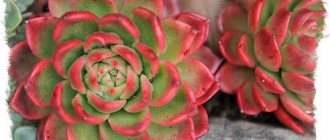Narrow-leaved peony (Paeonia tenuifolia) or funnel flower, lazarus flower, red lazorika is a beautifully flowering herbaceous plant of the Peony family, a rare species listed in the Red Book. Under natural conditions, the flower can still be found in the south of Russia: in the Tambov, Voronezh and Belgorod regions. It has been cultivated since the end of the 18th century.
As soon as the last snow melts, delicate pink shoots appear from the ground, which begin to grow very quickly, reaching a height of 50 cm. The angustifolia peony blooms at a time when many small-bulbed plants and daffodils with tulips have already faded. At this time, seedlings of herbaceous peonies are just beginning to sprout from the ground.
Angustifolia peony bushes have a spherical shape and openwork strongly dissected thread-like leaves. At the tops of the shoots, buds are formed, which turn into not very large (up to 8 cm in diameter), not double flowers of a bright crimson color. In the middle of the flower there are golden-yellow anthers that beautifully harmonize with the color of the petals. The most delicate aroma emanates from the petals, which cannot be compared with any artificially created one. Flowering continues for several days, during which it presents a stunning sight.
Terry varieties of narrow-leaved peony (P. tenuifolia Plena, P. tenuifolia Rosea) with oval flowers and anthers that are hidden between the petals are also known. For these varieties, flowering lasts up to 2.5 weeks. After flowering, a seed box with small black seeds forms in place of the flower.
Full description of mountain peony
This species is classified as endangered. The description of the mountain peony, a plant from the Red Book, was made in 1984. It is a perennial, characterized by cold resistance; in nature it can withstand even the most severe cold.
The rhizome of the plant is located horizontally in the ground, the bush has a straight single stem, 0.3-0.6 m tall, ribbed, with a purple stripe along the ribs, with large red-crimson integumentary scales at the base. The leaves of the peony are green, with red-violet veins, obovate in shape, three times trifoliate, with a solid, uncut edge. Wide – 18-28 cm in diameter. As you can see, the plant is different from peonies, which usually bloom in gardens, but it is also decorative in its own way.
Mountain peony has delicate flowers and is often located among stones
Where do mountain peonies grow?
Their habitat is the Far Eastern regions of Russia, Khabarovsk, Primorsky Krai, Sakhalin region. In addition to the Russian Federation, this species grows in Korea, Japan and China. The plant can be seen in mixed forests - both among coniferous trees and larches. Likes to grow in the shade, on gentle slopes or in floodplains.
Peony does not grow in large groups, does not form clearings or large clusters, and grows mainly in single specimens or small groups.
How does a mountain peony bloom?
Plants bloom in May. The flowers are simple, formed from 5-6 medium-sized petals, arranged in 1 row, light cream or yellowish, less often pink or white. The flowers are 6-12 cm in diameter. The corolla rests on a green, fleshy sepal. In the center there are up to 6 dozen bright yellow stamens with a purple base. The aroma of flowers is reminiscent of poppy.
After 2 months - at the end of July or beginning of August, the mountain peony ripens fruits with seeds. These are greenish-purple single-leafed leaves, each containing 4-8 brown seeds.
Why is the mountain peony listed in the Red Book?
The mountain peony is included in the Red Book, as its numbers have greatly decreased and are still at a low level. And there is still no hope that plants will independently restore their numbers to levels when they are not in danger of extinction.
The value of mountain peonies for the ecosystem
Since everything in nature is interconnected, the disappearance of a population of any plant species entails a disruption in the entire system. The same applies to mountain peony. Despite the fact that it does not serve as food for animals and does not form thickets that would noticeably affect the state of the ecosystem, it also has its significance as an ornamental plant.
Mountain peonies decorate clearings in the forest and fill spaces in young deciduous plantings
Reasons for the extinction of the species
The reasons for this state of the species are human activities: deforestation, which destroys the natural habitat of plants, forest fires.
This type of plant is also vulnerable because some people, walking through the forest, dig up rhizomes to try to grow flowers on their site. But they do not always succeed, because the plant, even if it takes root, grows poorly, since it is not in comfortable conditions. They also dig up the roots because they consider them medicinal, but this is a mistake; of the many types of peonies, only the medicinal and evasive peony (Maryin root) have medicinal properties.
The number of peonies is also reduced by the fact that people pick their flowers for bouquets. In this case, the bush itself is harmed, and the plants cannot set seeds and reproduce.
Measures to protect mountain peonies
Protected natural areas have been created in the Primorsky Territory and Sakhalin, where scientific, environmental and cultural activities are carried out aimed at protecting the mountain peony from destruction. In the regions it is prohibited to pick flowers and dig up plant rhizomes. All this should contribute to the fact that the number of beautiful flowers will gradually increase.
Reproduction methods
Most often, thin-leaved peony is planted using bush propagation. To do this, I use mature bushes that are about 5 years old; this method is less time-consuming and labor-intensive and helps rejuvenate the plant.
This is usually done in the fall. The plant is divided into parts (divisions) with 2-3 buds, and planted in a hole measuring 60x80 cm, with nutritious soil previously poured into it; during this period, you can also change its place of growth. The bushes are planted at a distance of a little more than half a meter from each other, sprinkling the buds with soil so that there is about 5 cm of soil above the buds, and be sure to sprinkle the cut areas with wood ash to avoid rotting. To top it all off, you need to pour a small hill around the seedlings and fertilize them with humus or peat. But you should not compact the soil at the planting site; the fragile roots of the plant suffer greatly from this.
Another, but no less popular, planting method is sowing seeds. It is more labor-intensive and time-consuming, and the most unpleasant thing about this method is that there is a high probability that the sown seeds may not sprout.
The seed pods are collected in July, when they have not yet opened, wrapped in paper and hidden in the refrigerator until mid-autumn. Almost before winter they are sown in loosened soil, and the plant will sprout with the arrival of spring. But thin-leaved peony is rarely propagated in this way, mainly solely due to the fact that in this case, at least five, or even six years will pass before the first flowering.
There is also a rarer method of propagation - by root cuttings and is also performed in the fall, since at this time the roots of the plant are formed. Vertical root layers are planted at a distance of 60-70 cm.
Is it possible to grow mountain peonies at home?
Mountain peonies propagated vegetatively can theoretically grow in private gardens. But in practice this happens quite rarely. Basically, to increase their numbers, they are grown in botanical gardens, using a scientific approach to this work. In suitable conditions, the mountain peony takes root and blooms.
Attention! Plants grown under artificial conditions are slightly different in appearance from wild ones: their leaves and flowers are larger, and their roots are more powerful. Sometimes they bloom earlier than in nature: in mid-April, and not as expected in May.
Factors influencing numbers
Mountain peonies suffer greatly due to man's irrational attitude towards nature. We have already talked about the fact that people thoughtlessly pick flowers in the forests. But the plant is brought to the brink of survival not only by this factor. Amateur gardeners dig up rhizomes to grow a beautiful flower in their garden plots. The forests in which the mountain peony feels best are being cut down. Often this logging is illegal, poached, pursuing only personal gain. In this case, people do not think about the preservation of herbaceous vegetation at all.
Damage to the mountain peony population is caused by forest fires, which most often occur due to human negligence. In addition, a serious limiting factor is the agricultural development of territories, which increases the recreational load on the forest. This means that human influence can lead to both a slight change in the forest landscape and complete degradation of the ecosystem, which is a disaster for nature.
How to propagate mountain peonies
This species reproduces in the same way as cultivated forms. Since it is impossible to completely dig up the bush, there is only one option left - to separate part of the root from it so that the plant does not die.
The root piece should be such that it contains a growth bud. After digging, you need to sprinkle the rhizome with soil so that the roots do not remain exposed. The best time for digging is the end of August or the beginning of autumn.
Advice! Before planting, it is recommended to soak the rhizome in a solution of any root growth stimulator for 1 day to increase the chances of survival. You cannot keep a mountain peony unplanted for a long time - the sooner you plant it, the better.
You can try another way: root a leaf cutting. Cut a part from the middle of the shoot; there should be an axillary bud on it. Plant the cuttings in a moist, loose substrate and root in a greenhouse at high humidity for about 1-1.5 months. Afterwards you can plant them in the garden.
Wild peonies, unlike garden peonies, reproduce well by seeds. The species characteristics are well preserved, so for home breeding you can grow the plant from seeds. To do this, you need to collect the fruits after they have ripened on the bush. Grow seedlings from them and then transplant them to a permanent place in the garden. The cultivation technology is the same as for cultivated peonies:
- Seeds are sown in a small bed in September-October.
- Before the onset of cold weather, it is covered with a layer of mulch.
- In the spring, as soon as the snow melts, the shelter is removed with the onset of sunny weather.
Before transplanting, peonies from seeds must grow in the garden bed for at least 1 year. They most likely will not bloom in the first few years of their life.
The first years after planting, sprouts need special care.
Reproduction
In most cases, peony is propagated by dividing bushes. Ideal breeding material is specimens 5 years old and older. Then less time and effort is wasted, and at the same time the plant is rejuvenated. Peonies are mainly divided in the fall.
Each division should have 2 or 3 buds. They need to be planted in holes measuring 0.6 x 0.8 m. Fertile soil is poured there in advance. It is allowed to change the place where the peony is grown at the same time as replanting. There should be approximately 0.5 m of clean soil between the bushes.
The buds need to be covered with soil, leaving about 0.05 m of soil above them. All cuts must be sprinkled with wood ash. If it is not used, the seedling may rot. The last step is backfilling a small earthen hill, to which peat or humus is mixed. Important: excessive compaction of the soil is unacceptable, as this may damage the roots.
Quite often peony seeds are used for propagation. This method is labor intensive and takes more time . In addition, there is a considerable danger that the crops will not sprout. But any experienced gardener will certainly try his hand at solving such a problem. And many successfully manage to overcome it.
The seed pods should be collected in July before they open. Next, these boxes should be wrapped in plain paper and placed in the refrigerator until mid-October. Almost before winter itself, the seeds are planted in loosened soil. Sprouts will appear in the spring.
But thin-leaved peonies are rarely propagated by seeds. And the point here is not only the labor intensity of the method. You will usually have to wait 5 years for the first flowering. And in some cases - another year more. Propagation by root cuttings is even less commonly used. This procedure is carried out in the fall, after waiting for the final formation of the roots. Layers are planted in increments of 0.6-0.7 m.
Planting and care
The place for the mountain peony in the garden must be chosen so that it is in the shade or partial shade, because it is in such conditions that it grows in nature. Dig up the area where the plant will be located and add humus and ash to it, especially if the soil is poor and has not been fertilized for a long time.
Mountain peony is replanted early in spring or autumn - before or after the end of the growing season. The dimensions of the planting hole must exceed the volume of the roots of the seedling being planted. It needs to be deepened so that the growth buds are covered with soil. Then water the seedling with water.
Caring for a mountain peony is simple: it needs to be watered frequently in the first month, making sure that the ground is always moist. After rooting, you can water only in hot weather; the rest of the time the plant will have enough moisture from the rains.
It is enough to feed once per season - in early spring or autumn, using mineral or organic fertilizers. There is no need to overfeed, this will not make the flowers larger or more luxuriant.
Preparations for winter should be carried out during autumn work in the garden: cut off wilted stems, take them out and burn them, lightly dig up the bush to give air to the roots, then sprinkle with leaves or any other type of mulch. However, even if there is no insulation, the plant should not freeze, since it is much more resistant to cold than varietal peonies.
Problems during cultivation
The plant is resistant to diseases and pests, but problems can arise if not cared for properly.
- Sometimes shoots and buds can be damaged by spring frosts.
- Also, in early spring, germinating shoots are affected by gray mold, powdery mildew or aphids, and young buds are eaten by caterpillars and ants.
- The roots may rot if the soil is constantly waterlogged or drainage was not done during planting.
Read also: Blueberry planting and care in open ground in the Moscow region
It is necessary to process the plant in a timely manner to prevent disease; if it was not possible to secure the bushes in advance , you will have to deal with emerging problems .
Pests and diseases
The mountain peony has a stronger immune system than the domestic peony, so it usually does not get sick. But under favorable conditions for pathogens, some plants can be affected by fungal diseases, and a little less often - viral ones. After establishing the cause, you need to carry out treatment: treat the bushes with drugs.
The same applies to pests. Most often, ants damage peonies. If insects are found on the buds, you need to use folk remedies to combat them, for example, mix sugar or honey with boric acid and scatter them near the bush. Attracted by the sweet bait, the ants will die.
You can spray the peony with an infusion of herbs whose smell pests do not like: bay leaf, parsley, tansy, wormwood, marigold, lavender, mint or garlic infusion. If this does not help, you need to use chemical insecticides.
Among garden pests, aphids can settle on plants. You can also fight it using traditional methods: spraying it with ash, soap or tobacco infusion. It is quite possible that one time will not be enough to completely get rid of pests, so after some time (about 1.5 weeks) you need to repeat spraying. As in the case of ants, it is advisable to use agrochemicals only in extreme cases.
Beneficial features
Thin-leaved peony is considered poisonous because its roots contain neonin, but nevertheless it is widely used to treat a number of diseases. For a long time it has been used as an antispasmodic, diuretic, expectorant, bactericidal, protistocidal (antiparasitic) and sedative. It helps well with heart pain, kidney and bladder stones, concussions, nervous diseases, as well as in the treatment of anemia and gout. Pulmonary tuberculosis is treated with an infusion of peony rhizomes. Among other things, Peony contains in all its parts many other useful components for medicinal use, such as: tannins, anthocyanins, flavonoids, vitamin C and fatty oil.
This incomparable shrub is often decorated with all kinds of landscape designs. Peony will decorate any slides and rock gardens and gets along well with plants and shrubs in mixed borders. Often combined with other varieties of peonies, taking into account their flowering at different times, thin-leaved peonies are planted alone, which does not imply splendor.
The fine-leaved peony, with its showiness, will for a long time bring great aesthetic pleasure not only to the gardener, but also to his guests; the striking coloring of its flowers and unusual leaves will not leave anyone indifferent.
Source











